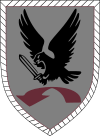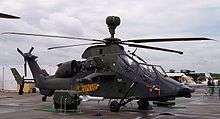Airmobile Operations Division (Germany)
Airmobile Operations Division (Division Luftbewegliche Operationen) was a division of the German Army. The division was founded on 1 July 2002 and reported for duty 8 October 2002.[1] Airmobile Operations Division consisted of approximately 14,500 soldiers, 350 of which were stationed at divisionary headquarters in Veitshöchheim, Germany.[2]
| Airmobile Operations Division Division Luftbewegliche Operationen | |
|---|---|
 Airmobile Operations Division Shoulder Insignia | |
| Active | In current form: July 2002 – June 2014 |
| Country | Germany |
| Branch | Army |
| Type | Division |
| Role | Air assault, providing specialized forces |
| Size | About 14,600 soldiers |
| Part of | German Army |
| Garrison/HQ | Veitshöchheim |
| Motto(s) | Forwards! Nach vorn! |
| Anniversaries | July 1 |
| Engagements | Kosovo war War in Afghanistan
|
| Commanders | |
| Current commander | Major General Benedikt Zimmer |
| Notable commanders | Lieutenant General Hans-Otto Budde, former commander of the German Army |
In October 2011 the German Federal Ministry of Defence announced a reorganisation/reduction of the German Armed Forces. As a consequence, Airmobile Operations Division was dissolved and those units not being disbanded altogether were either transferred to other parts of the armed forces or incorporated into a different command structure.[3] The division itself was officially disbanded on 26 June 2014[4] and was integrated into the 10th Armoured Division which relocated from Sigmaringen to Veitshöchheim.[5]
Tasks
The tasks of the division were unique within the modern German military in that it was able to provide air mobility as well as ground-based fire support, aerial defence and counter chemical, biological, radiological, and nuclear assets to all parts of the German military. With an additional infantry component, it was also capable of limited air assault operations. The division's command was prepared to fulfil a role as Framework Headquarters for NATO and EU operations. Troops of Airmobile Operations Division also render assistance to civilian authorities during disaster relief operations.[6]
Coat of arms and motto
The coat of arms of Airmobile Operations Division depicts a flying black eagle, with its wings turned upright, holding a sword in its claws on a argent. Below the eagle a red arrow is shown. The argent symbolises dedication and the eagle strength, courage and bravery. The eagle's upturned wings, somewhat unusual in heraldry, represent the lunging out for new power. The sword stands for strike capability and penetration depth. The red arrow illustrates the third dimension, the depth of space and the dynamics of the division. The framing silver cord shows the status as a division. The maroon coloured seam corresponds with the traditional beret colour of the Army Aviation Corps and airborne forces.
The division's motto was the same as the German Army Aviation Corps': Nach vorn! which translates as either "Forward!" or "To the front!".
Deployment
Units of Airmobile Operations Division were deployed in a number of missions under the aegis of either the United Nations, the European Union or NATO.
- SFOR in Bosnia and Herzegovina (ended 2003)
- KFOR (ended 2003)
- Disaster relief following the earthquake in Kashmir, Pakistan (2005-2006))
- EUFOR RD Congo in the Democratic Republic of the Congo (2006)
- ISAF in Afghanistan (from 2002)
Structure
Airmobile Operations Division's staff was based at Veitshöchheim. The division incorporated units from various branches of the German Army. These units were stationed all over Southern and Central parts of Germany.
The following units were directly subordinate to Airmobile Operations Division:
| Name of unit | Based at | Insignia | Note |
|---|---|---|---|
| Army Band 12 | Veitshöchheim | Incorporated into the Military Music Center of the Bundeswehr in 2013 | |
| Signals Battalion Airmobile Operations Division | Veitshöchheim | Disbanded in 2013 | |
| Light Transport Helicopter Regiment 30 | Niederstetten | Incorporated into the Rapid Forces Division | |
| Medium Transport Helicopter Regiment 15 "Münsterland" | Rheine | Disbanded on 7 March 2013; helicopters transferred to the German Air Force's Helicopter Wing 64[7] | |
| Medium Transport Helicopter Regiment 25 "Oberschwaben" | Laupheim | Disbanded on 5 March 2013; re-established as the German Air Force's Helicopter Wing 64[8] | |
| Artillery Demonstration Regiment 345 | Kusel | Relocated to Idar-Oberstein and incorporated into 10th Armoured Division[9] | |
| CBRN Defence Regiment 750 "Baden" | Bruchsal | Restructured into CBRN Defence Battalion 750 "Baden" and now part of Joint Support Service | |
| Light CBRN Defence Company 120 | Sonthofen | Disbanded | |
| Security Battalion 12 | Hardheim | Assigned to 10th Panzer Division[10] | |
| Army Combat Support Brigade | Bruchsal | Disbanded on 31 December 2012 | |
| Airmobile Brigade 1 | Fritzlar | Disbanded on 17 December 2013 | |
The following units were subordinate to Airmobile Brigade 1:
| Name of unit | Based at | Insignia | Note |
|---|---|---|---|
| Staff Company | Fritzlar | Disbanded on 17 December 2013 | |
| Air Assault Infantry Regiment 1 | Schwarzenborn | Transferred to 21st Armoured Brigade;[11] to be disbanded and reformed as Light Infantry Battalion 1 | |
| Light Transport Helicopter Regiment 10 "Lüneburger Heide" | Faßberg | Incorporated into the Rapid Forces Division | |
| Attack Helicopter Regiment 26 "Franken" | Roth | Disbanded on 30 June 2014 | |
| Attack Helicopter Regiment 36 "Kurhessen" | Fritzlar | Incorporated into the Rapid Forces Division | |
Commanders
| Nr | Name | Begin | End |
|---|---|---|---|
| 4 | Brigadier General Benedikt Zimmer | 20 December 2012 | 26 Juni 2014 |
| 3 | Major General Erhard Drews | 12 February 2009 | 20 December 2012 |
| 2 | Major General Carl-Hubertus von Butler | 25 August 2005 | 12 February 2009 |
| 1 | Major General Dieter Budde | 2002 | 25 August 2005 |
Equipment
Armoured Vehicles
- Light air-transportable armoured fighting vehicle Wiesel 1 and Wiesel 2
- Air-transportable, armoured multirole transport vehicle Mungo
- Anti-aircraft cannon tank Gepard
- Surface-to-air missile light armoured tank Ozelot
- Armoured Howitzer 2000
Helicopters
- Light transport helicopter Bell UH-1D
- Medium transport helicopter Sikorsky CH-53 G/GS
- Light anti-tank helicopter Bo 105P/PAH-1A1
- Light liaison- and reconnaissance helicopter Bo 105 P1M
- Attack helicopter Tiger
- Medium transport helicopter NH-90
 Light armoured fighting vehicle Wiesel 1
Light armoured fighting vehicle Wiesel 1 Surface-to-air missile light armoured tank Ozelot
Surface-to-air missile light armoured tank Ozelot Transport vehicle Mungo in Afghanistan
Transport vehicle Mungo in Afghanistan Anti-aircraft cannon tank Gepard
Anti-aircraft cannon tank Gepard Armoured Howitzer 2000
Armoured Howitzer 2000 Bell UH-1D
Bell UH-1D Bo 105 PAH-1
Bo 105 PAH-1 Eurocopter Tiger
Eurocopter Tiger CH-53G
CH-53G NH-90
NH-90
References
- "Division Luftbewegliche Operationen - Geschichte". Federal Ministry of Defence. 7 August 2012. Retrieved 17 February 2013.
- "Division Luftbewegliche Operationen - Darstellung der eigenen Dienststelle". Federal Ministry of Defence. 7 August 2012. Retrieved 17 February 2013.
- Quoted from Bundesministerium der Verteidigung (26 October 2011), Neues Stationierungskonzept der Bundeswehr (in German), retrieved 5 November 2011, PDF-file "Die Stationierung der Bundeswehr in Deutschland", p. 62
- "Eine Erfolgsgeschichte endet – eine andere wird fortgesetzt". Federal Ministry of Defence. 20 December 2012. Retrieved 15 April 2015.
- "Division Luftbewegliche Operationen - Auftrag =". Federal Ministry of Defence. 7 August 2012. Retrieved 17 February 2013.
- "Division Luftbewegliche Operationen - Kommandoübergabe bei der Division Luftbewegliche Operationen". Federal Ministry of Defence. 10 January 2012. Retrieved 17 February 2013.
- Schnief, Matthias (6 March 2013), "Bundeswehr: Der letzte Akt für die "15er"", Münsterländische Zeitung (in German), archived from the original on 2013-03-08, retrieved 11 April 2013
- Ray, Roland (5 March 2013), "Der General rollt die Fahne ein", Schwäbische Zeitung (in German), archived from the original on 12 April 2013, retrieved 6 March 2013
- "Kusel - Vor dem 1. Juli passiert mal noch nichts", Die Rheinpfalz (in German), 27 February 2013, archived from the original on 2015-03-16, retrieved 23 April 2013
- http://www.deutschesheer.de/portal/a/heer/!ut/p/c4/04_SB8K8xLLM9MSSzPy8xBz9CP3I5EyrpHK9jNTUIr2UzNS84pLiEj1Dg4KqlMwyvfSclHT9gmxHRQA8dxqG/
- "Ein Schritt in Richtung Zielstruktur - 1.500 neue Soldatinnen und Soldaten für die Panzerbrigade 21 "Lipperland"" (in German). Federal Ministry of Defence. 19 December 2012. Retrieved 16 June 2013.
Further reading
- Garben, Fritz (2005), Deutsche Heeresflieger: nationale und internationale Rettungs-, Hilfs- und UN-Einsätze, Lemwerder: Stedinger-Verlag, ISBN 3-927697-41-9
- Garben, Fritz (2006), Fünf Jahrzehnte Heeresflieger: Typen, Taktik und Geschichte, Lemwerder: Stedinger-Verlag, ISBN 3-927697-45-1
- Hubatschek, Gerhard (2003), Das Heer im Einsatz, Frankfurt am Main: Report-Verlag, ISBN 3-932385-12-8
- Hubatschek, Gerhard (2006), 50 Jahre Heer. Der Soldat und seine Ausrüstung, Sulbach: Report-Verlag, ISBN 3-932385-21-7
- Schulz, Lothar (2003), Die Zukunft hat begonnen. Neues Heeresamt und Logistikzentrum Heer, Bonn: Report-Verlag